chapter 3
Objectives
- Introduce the basic input devices
- Physical Devices
- Logical Devices
- Input Modes
- Event-driven input
- Introduce double buffering for smooth animations
- Programming event input with GLUT
Project Sketchpad
- Ivan Sutherland (MIT 1963) established the basic interactive
paradigm that characterizes interactive computer graphics:
- User sees an object on the display
- User points to (picks) the object with an input device (light pen, mouse, trackball)
- Object changes (moves, rotates, morphs)
- Repeat
3.2- Graphical Input
- Devices can be described either by
- Physical properties
- Mouse
- Keyboard
- Trackball
- Logical Properties
- What is returned to program via API
- A position
- An object identifier
- What is returned to program via API
- Modes
- How and when input is obtained
- Request or event
- How and when input is obtained
- Physical properties
Physical Devices

Incremental (Relative) Physical Devices
- Devices such as the data tablet return a position directly to the operating system
- Devices such as the mouse, trackball, and joy stick return
incremental inputs (or velocities) to the operating system
- Must integrate these inputs to obtain an absolute position
- Rotation of wheels in mouse
- Roll of trackball
- Difficult to obtain absolute position
- Can get variable sensitivity
Logical Devices
- Consider the C and C++ code
- C++: cin >> x;
- C: scanf (“%d”, &x);
- What is the input device?
- Can’t tell from the code
- Could be keyboard, file, output from another program
- The code provides logical input
- A number (an int) is returned to the program regardless of the physical device
Graphical Logical Devices
- Graphical input is more varied than input to standard programs which is usually numbers, characters, or bits
- Two older APIs (GKS, PHIGS) defined six types of logical
input
- Locator: return a position
- Pick: return ID of an object
- Keyboard: return strings of characters
- Stroke: return array of positions
- Valuator: return floating point number
- Choice: return one of n items
Input Modes
- Input devices contain a trigger which can be used to send a
signal to the operating system
- Button on mouse
- Pressing or releasing a key
- When triggered, input devices return information (their
measure) to the system
- Mouse returns position information
- Keyboard returns ASCII code
Request Mode Input
- provided to the program only when user triggers the device
- Typical of keyboard input
- Can erase (backspace), edit, correct until enter (return) key (the trigger) is depressed

Event Mode Input
- Most systems have more than one input device, each of which can be triggered at an arbitrary time by a user
- Each trigger generates an event whose measure is put in an event queue which can be examined by the user program

Event Types
- Window: resize, expose
- Mouse: click one or more buttons
- Motion: move mouse
- Keyboard: press or release a key
- Idle: nonevent
- Define what should be done if no other event is in queue
Callbacks
- Programming interface for event-driven input
- Define a callback function for each type of event the API recognizes
- This user-supplied function is executed when the event occurs
- GLUT example: glutMouseFunc(mymouse)
GLUT callbacks(GLUT_3
Specification.pdf)
- GLUT recognizes a subset of the events recognized by any
particular window system (Windows, X, Macintosh)
- glutDisplayFunc
- glutMouseFunc
- glutReshapeFunc
- glutKeyboardFunc
- glutIdleFunc
- glutMotionFunc, glutPassiveMotionFunc
GLUT Event Loop
- Remember that the last line in main.c for a program using
GLUT must be
glutMainLoop();
which puts the program in an infinite event loop
- In each pass through the event loop, GLUT looks at the
events in the queue
- for each event in the queue, GLUT executes the appropriate callback function if one is defined
- if no callback is defined for the event, the event is ignored
The display callback
- The display callback is executed whenever GLUT determines
that the window should be refreshed, for example
- When the window is first opened
- When the window is reshaped
- When a window is exposed
- When the user program decides it wants to change the display
- In main.c
- glutDisplayFunc(mydisplay) identifies the function to be executed
- Every GLUT program must have a display callback
Posting redisplays
- Many events may invoke the display callback function
- Can lead to multiple executions of the display callback on a single pass through the event loop
- We can avoid this problem by instead using
glutPostRedisplay();
- which sets a flag.
- GLUT checks to see if the flag is set at the end of the
event loop
- If set then the display callback function is executed
Animating a Display
- When we redraw the display through the display callback, we
usually start by clearing the window
- glClear()
then draw the altered display
- Problem: the drawing of information in the frame buffer is
decoupled from the display of its contents
- Graphics systems use dual ported memory
- Hence we can see partially drawn displays
- See the program single_double.c for an example with a rotating cube
Double Buffering
- Instead of one color buffer, we use two
- Front Buffer: one that is displayed but not written to
- Back Buffer: one that is written to but not displayed
- Program then requests a double buffer in main.c
glutInitDisplayMode(GL_RGB | GL_DOUBLE)
- At the end of the display callback buffers are swapped
void mydisplay() {glClear();/* draw graphics here */glutSwapBuffers(); } - Code - single vs double buffering
- Youtube
example
Using the idle callback
- The idle callback is executed whenever there are no events
in the event queue
glutIdleFunc(myidle)
- Useful for animations
void myidle() {/* change something */t += dt;glutPostRedisplay(); }void mydisplay() {glClear();/* draw something that depends on t */glutSwapBuffers(); } -
Go back and examine the Vertex Colored cube code
Using globals
- The form of all GLUT callbacks is fixed
- void mydisplay()
- void mymouse(GLint button, GLint state, GLint x, GLint y)
- Must use globals to pass information to callbacks
float t; /*global */void mydisplay() {/* draw something that depends on t }
3.5 - Working with Callbacks
Objectives
- Learn to build interactive programs using GLUT callbacks
- Mouse
- Keyboard
- Reshape
- Introduce menus in GLUT
The mouse callback
glutMouseFunc(mymouse)
void mymouse(GLint button, GLint state, GLint x, GLint y)
- Returns
- which button (GLUT_LEFT_BUTTON, GLUT_MIDDLE_BUTTON, GLUT_RIGHT_BUTTON) caused event
- state of that button (GL_UP, GLUT_DOWN)
- Position in window
Positioning
- The position in the screen window is usually measured in
pixels with the origin at the top-left corner
- Consequence of refresh done from top to bottom
- OpenGL uses a world coordinate system with origin at the
bottom left
- Must invert y coordinate returned by callback by height of window
- y = h – y;

Obtaining the window size
- To invert the y position we need the window height
- Height can change during program execution
- Track with a global variable
- New height returned to reshape callback that we will look at in detail soon
- Can also use enquiry functions
glGetIntvglGetFloatv
to obtain any value that is part of the state
Terminating a program
- In our original programs, there was no way to terminate them through OpenGL
- We can use the simple mouse callback
void mouse(int btn, int state, int x, int y) {
if(btn==GLUT_RIGHT_BUTTON && state==GLUT_DOWN) exit(0); }
Using the mouse position
- In the next example, we draw a small square at the location of the mouse each time the left mouse button is clicked
- This example does not use the display
callback but one is required by GLUT; We can use the empty
display callback function
mydisplay(){}
Drawing squares at cursor location
void mymouse(int btn, int state, int x, int y) {
if(btn==GLUT_RIGHT_BUTTON && state==GLUT_DOWN) exit(0);
if(btn==GLUT_LEFT_BUTTON && state==GLUT_DOWN) drawSquare(x, y); }
void drawSquare(int x, int y) {
y=w-y; /* invert y position */
glColor3ub( (char) rand()%256, (char) rand )%256, (char) rand()%256);
/* a random color */
glBegin(GL_POLYGON);glVertex2f(x+size, y+size);
glVertex2f(x-size, y+size);
glVertex2f(x-size, y-size);
glVertex2f(x+size, y-size);glEnd(); }
-
Code - drawing squares with mouse
Using the motion callback
- We can draw squares (or anything else)
continuously as long as a mouse button is depressed by using
the motion callback
glutMotionFunc(drawSquare)
- We can draw squares without depressing a
button using the passive motion callback
glutPassiveMotionFunc(drawSquare)
Using the keyboard
glutKeyboardFunc(mykey)
void mykey(unsigned char key, int x,
int y)
- Returns ASCII code of key depressed and
mouse location
- Note GLUT does not recognize key release as
an event
void mykey() { if(key == ‘Q’ || key == ‘q’) exit(0); }
Special and Modifier
Keys
- GLUT defines the special keys in glut.h
- Function key 1: GLUT_KEY_F1
- Up arrow key: GLUT_KEY_UP
if(key == ‘GLUT_KEY_F1’ ……
- Can also check if one of the modifiers
- GLUT_ACTIVE_SHIFT
- GLUT_ACTIVE_CTRL
- GLUT_ACTIVE_ALT
is depressed by glutGetModifiers()
- Allows emulation of three-button mouse
with one- or two-button mice
Reshaping the window
- We can reshape and resize the OpenGL display
window by pulling the corner of the window
- What happens to the display?
- Must redraw from application
- Two possibilities
- Display part of world
- Display whole world but force to fit
in new window
- Can alter aspect ratio
Reshape possiblities
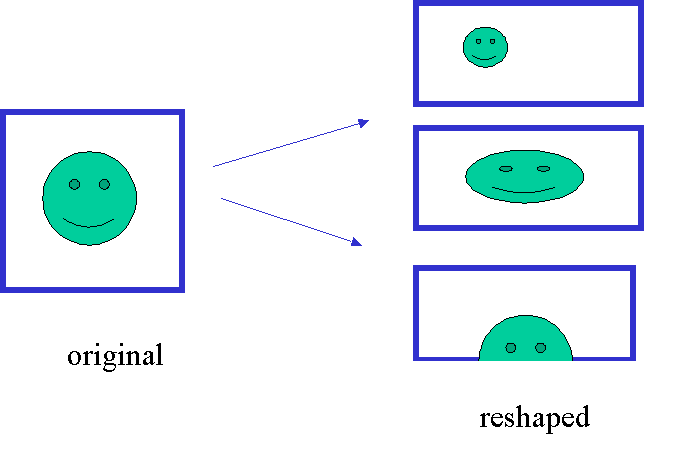
The Reshape callback
glutReshapeFunc(myreshape)
void myreshape( int w, int h)
Returns width
and height of new window (in pixels)
- A redisplay is posted automatically at end
of execution of the callback
- GLUT has a default reshape callback but
you probably want to define your own
- The reshape callback is good place to put
camera functions because it is invoked when the window is
first opened
Example Reshape
- This reshape preserves shapes by making the
viewport and world window have the same aspect ratio
void myReshape(int w, int h) {
glViewport(0, 0, w, h);
glMatrixMode(GL_PROJECTION); /* switch matrix mode */
glLoadIdentity();
if (w <= h) gluOrtho2D(-2.0,2.0, -2.0 * (GLfloat) h /
(GLfloat) w, 2.0 * (GLfloat) h / (GLfloat) w);
else gluOrtho2D(-2.0 * (GLfloat) w / (GLfloat) h,
2.0 * (GLfloat) w / GLfloat) h, -2.0, 2.0);
glMatrixMode(GL_MODELVIEW); /* return to modelview mode */ }
Toolkits and Widgets
- Most window systems provide a toolkit or
library of functions for building user interfaces that use
special types of windows called widgets
- Widget sets include tools such as
- Menus
- Slidebars
- Dials
- Input boxes
- But toolkits tend to be platform dependent
- GLUT provides a few widgets including menus
Menus
- GLUT supports pop-up menus
- A menu can have submenus
- Three steps
- Define entries for the menu
- Define action for each menu item
- Action carried out if entry selected
- Attach menu to a mouse button
Defining a simple menu
- In main.c

Menu actions
- Menu callback

- Note each menu has an id that is returned
when it is created
- Add submenus by
glutAddSubMenu(char *submenu_name,
submenu id)
Other functions in GLUT
- Dynamic Windows
- Create and destroy during execution
- Subwindows
- Multiple Windows
- Changing callbacks during execution
- Timers
- Portable fonts
glBitMap(int w, int h, float
xOrigin, float yOrigin, float xStep, float yStep,
unsigned byte *bitmap); See
drawf.c
glutBitmapCharacter(float *font,
int character); See newpaint.c
glutStrokeCharacter - not covered. See examples in OpenGL Book code
folder, stoke.c
3.7 - Better Interactive Programs
Objectives
- Learn to build more sophisticated
interactive programs using
- Picking
- Select objects from the display
- Three methods
- Rubberbanding
- Interactive drawing of lines and
rectangles
- Display Lists
- Retained mode graphics
Picking
- Identify a user-defined object on the
display
- In principle, it should be simple because
the mouse gives the position and we should be able to
determine to which object(s) a position corresponds
- Practical difficulties
- Pipeline architecture is feed forward,
hard to go from screen back to world coordinates
- Complicated by screen being 2D, world is
3D
- How close do we have to come to object
to say we selected it?
Three Approaches
- Hit list (skip)
- Most general approach but most difficult
to implement
- (skip) Use back or some other buffer to store
object ids as the objects are rendered
- Rectangular maps
- Easy to implement for many applications
-
Using Regions of the
Screen
- Many applications use a simple
rectangular arrangement of the screen
- Example: paint/CAD program
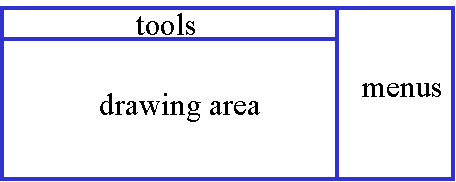
- Easier to look at mouse position and
determine which area of screen it is in
- See paint program in text
- Code - paint program
- Code - picking (other examples
- picksquare.c , pickdepth.c)
Hit Lists (skip)
Rendering Modes
- OpenGL can render in one of three modes
selected by
- glRenderMode(mode)
- GL_RENDER: normal rendering to the frame
buffer (default)
- GL_FEEDBACK: provides list of primitives
rendered but no output to the frame buffer
- GL_SELECT: Each primitive in the view
volume generates a hit record that is placed in a name
stack which can be examined later
Selection Mode Functions
- glSelectBuffer(): specifies name buffer
- glInitNames(): initializes name buffer
- glPushName(id): push id on name buffer
- glPopName(): pop top of name buffer
- glLoadName(id): replace top name on buffer
- id is set by application program to
identify objects
Using Selection Mode
- Initialize name buffer
- Enter selection mode (using mouse)
- Render scene with user-defined identifiers
- Reenter normal render mode
- This operation returns number of hits
- Examine contents of name buffer (hit
records)
- Hit records include id and depth
information
Selection Mode and Picking
- As we just described it, selection mode
won’t work for picking because every primitive in the view
volume will generate a hit
- Change the viewing parameters so that only
those primitives near the cursor are in the altered view
volume
- Use gluPickMatrix (see text for details)
- Look at pick.c code
Using another buffer and
colors for picking
- For a small number of objects, we can assign
a unique color (often in color index mode) to each object
- We then render the scene to a color buffer
other than the front buffer so the results of the rendering
are not visible
- We then get the mouse position and use
glReadPixels() to read the color in the buffer we just wrote
at the position of the mouse
- The returned color gives the id of the
object
Writing Modes
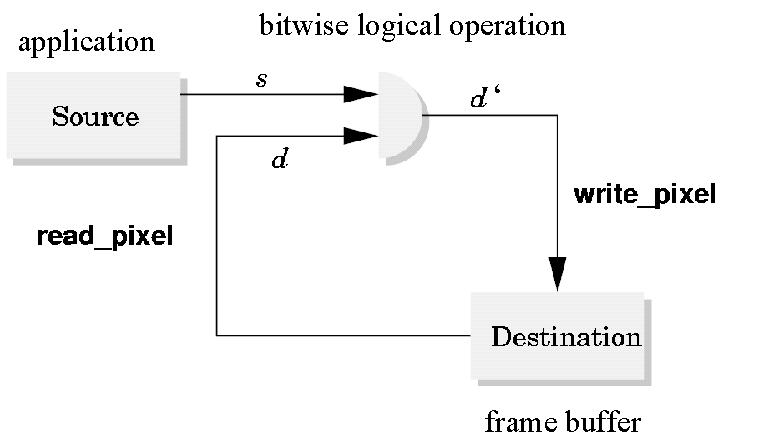
XOR write
- Usual (default) mode: source replaces
destination (d’ = s)
- Cannot write temporary lines this way
because we cannot recover what was “under” the line in a
fast simple way
- Exclusive OR mode (XOR) (d’ = d
 s)
s)
- x
 y
y  x =x
x =x
- Hence, if we use XOR mode to write a
line, we can draw it a second time and the line is
erased!
Rubberbanding
- Switch to XOR write mode
- Draw object
- For line can use first mouse click to
fix one endpoint and then use motion callback to
continuously update the second endpoint
- Each time mouse is moved, redraw line
which erases it and then draw line from fixed first
position to new second
position
- At end, switch back to normal drawing
mode and draw line
- Works for other objects: rectangles,
circles
Rubberband Lines
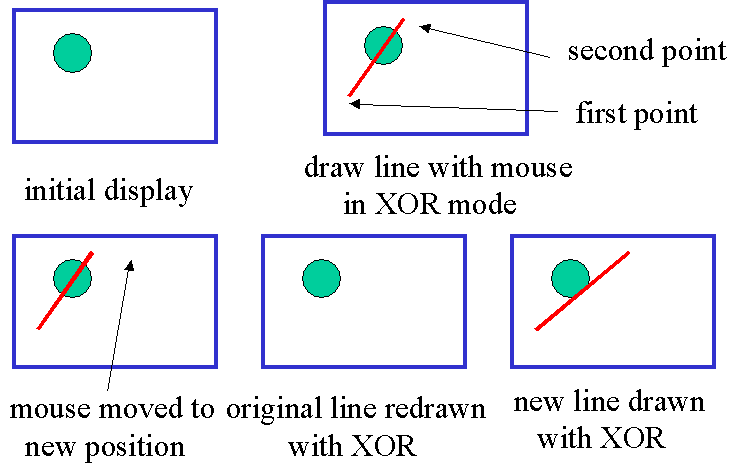
XOR in OpenGL
- There are 16 possible logical operations
between two bits
- All are
supported by OpenGL
- Must first enable logical operations
glEnable(GL_COLOR_LOGIC_OP)
- Choose logical operation
glLogicOp(GL_XOR)
glLogicOp(GL_COPY) (default)
- See XorLines.c
code
Immediate and Retained
Modes
- Recall that in a standard OpenGL program,
once an object is rendered there is no memory of it and to
redisplay it, we must re-execute the code for it
- Known as immediate mode graphics
- Can be especially slow if the objects
are complex and must be sent over a network
- Alternative is define objects and keep them
in some form that can be redisplayed easily
- Retained mode graphics
- Accomplished in OpenGL via display lists
Display Lists(see code list.c; )
- Conceptually similar to a graphics file
- Must define (name, create)
- Add contents
- Close
- In client-server environment, display list
is placed on server
- Can be redisplayed without sending
primitives over network each time
Display List Functions
Creating a display list
GLuint id;
void init( void ) {
id = glGenLists( 1 );
glNewList(id, GL_COMPILE );
/* other OpenGL routines */
glEndList(); }
Call a created list
void display( void ) {
glCallList( id ); }
3.4 (briefly) Display
Lists and State
- Most OpenGL functions can be put in display
lists
- State changes made inside a display list
persist after the display list is executed
- Can avoid unexpected results by using
glPushAttrib and glPushMatrix upon entering a display list
and glPopAttrib and glPopMatrix before exiting
Hierarchy and Display Lists
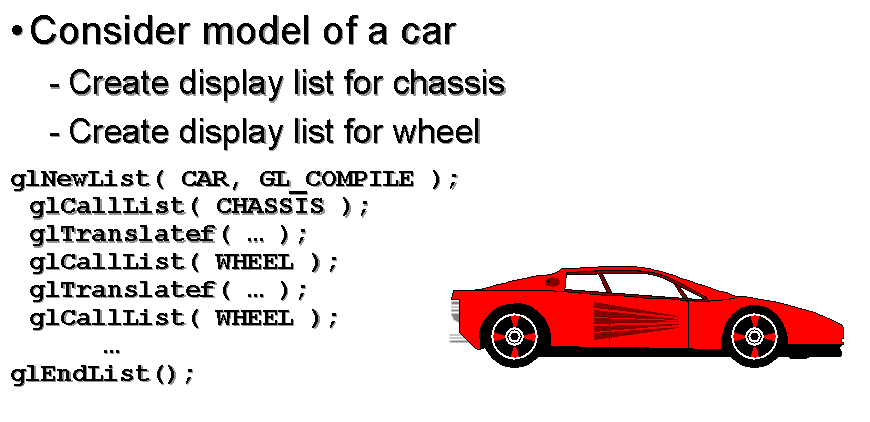
In class Activity link